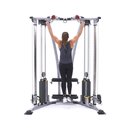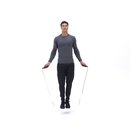Exercise enthusiasts tend to be creatures of habit. We're most comfortable in the conventional gym construct, where dumbbells, cardio machines, and exercise-class equipment serve as visual reminders of what has worked for us in the past.
But if we unplug from this matrix of familiar foes, we can actually force new adaptations, lose more body fat than ever before, and recover from the monotony of staring at walls. One easy way to instantly disrupt this complacency is to take your training outside.
Unless you're buried in snow or oppressed by Sahara-type heat, exercising outdoors comes with a host of body-friendly benefits. Sure, there's the plateau-defying value of changing things up a bit. But training outside gives you a passive dose of Vitamin D, which is critical in the production of testosterone. What's more, research shows that you're more likely to stick to a workout program, enjoy yourself more, and have stronger intentions for future workouts when you exercise outdoors.[1,2] It's truly amazing what a little fresh air can do to reinvigorate a routine.

Taking your routine outdoors can help you learn to love your workouts again!
These four routines can be programmed into your existing workouts or just used as one-offs to provide a fresh spark. They speak to the heart of you, the Bodybuilding.com audience. These workouts require little more than your body weight and a willingness to smash through limits. They hold real-world, tangible benefits to your body, including strong muscles, decreased body fat, and improved performance. You can still be a creature of habit, but now, you'll be one with more strength and conditioning tools at your disposal.
Before getting started, remember that training in hot weather requires some precautions. Heat and humidity affect body temperature, and hydration becomes more important as well.
Oh, and don't forget the sunscreen!
Workout 1: No Equipment Required
Setting: Any playground with bars or fitness trail.

BodyFit
$6.99/month- 2,500+ expert-created single workouts
- 3,500+ how-to exercise videos
- Detailed workout instruction
- Step-by-step workout tips
- Training at gym or at home
- Access to Workout Plans
- Access to Bodyfit App
- Store Discounts
Already have a Bodybuilding.com account with BodyFit? Sign In

What comes with BodyFit?

- Instructional Videos
Don't risk doing a workout improperly! Avoid injury and keep your form in check with in-depth instructional videos.

- How-to Images
View our enormous library of workout photos and see exactly how each exercise should be done before you give it a shot.

- Step-by-Step Instructions
Quickly read through our step-by-step directions to ensure you're doing each workout correctly the first time, every time.
This little circuit is much more sinister than it looks. It goes beyond using your body weight and requires you to test your muscular endurance in a circuit setting, elevating your metabolism and caloric burn. Pull-ups and dips combine to work a heap of upper-body muscle. Varying your hand position on each round of pull-ups will emphasize different areas of the lats. An underhand grip, for example, will activate your biceps to a higher degree; a wider grip involves less elbow flexion, forcing your lats to work harder.
Dips are also very versatile. By keeping your elbows tight and your body upright, you emphasize the triceps, while a slight forward lean and flared elbows set your lower pecs on fire. (Note: Bring gloves if you have trouble gripping a bar that may be smooth.)
Scale down: Cut everything in half. Do 5 pull-ups, 5 dips, 5 hanging leg raises, and 5 jump squats, followed by a 15-second run. Rest no more than 60 seconds between rounds.
Scale up: Challenge yourself by performing as many rounds as you can in 15 minutes, forgoing the prescribed rest between sets. Strive to complete more rounds each time you tackle this workout.
Workout 2: Sprint to Shred
Setting: Any flat trail, street, or field.

BodyFit
$6.99/month- 2,500+ expert-created single workouts
- 3,500+ how-to exercise videos
- Detailed workout instruction
- Step-by-step workout tips
- Training at gym or at home
- Access to Workout Plans
- Access to Bodyfit App
- Store Discounts
Already have a Bodybuilding.com account with BodyFit? Sign In

What comes with BodyFit?

- Instructional Videos
Don't risk doing a workout improperly! Avoid injury and keep your form in check with in-depth instructional videos.

- How-to Images
View our enormous library of workout photos and see exactly how each exercise should be done before you give it a shot.

- Step-by-Step Instructions
Quickly read through our step-by-step directions to ensure you're doing each workout correctly the first time, every time.
Tip: Download the GymBoss app for free on your SmartPhone and set it for 10 15-second sprints with 45 seconds of recovery.
High-intensity interval training (HIIT) remains the preferred choice of serious athletes when it comes to burning more fat while sparing muscle tissue. And while HIIT can take many forms, sprinting is one of the best-researched methods at your disposal. Studies also show that it provides muscle and performance adaptations similar to traditional endurance training.[3]
This high-powered, condensed workout calls for a bit of explosive activity before diving into a Usain Bolt-like series of sprints. Three minutes of jumping rope serves as a more active warm-up than cold stretching, which is not advisable before exercise. Dynamic activity such as jumping rope better prepares the joints and central nervous system for more rigorous activity while also raising core temperature. The rope also has the benefit of preparing the tendons of the feet and calves for the ballistic nature of the sprints.

HIIT exercises like sprints burn more fat and spare more muscle than steady-state cardio and take less time.
A low-volume jump squat routine follows, further encouraging the fast-twitch fibers of your lower body to fire quickly when called upon during your sprints. This is the result of a phenomenon known as post-activation potentiation, an underused tool for HIIT devotees.
The sprints call for a max-effort run for 15 seconds at the top of each minute. This relatively short effort allows you to work up to and briefly maintain top speed, unlike longer sprints (30-60 seconds) that start to abuse multiple energy systems. You'll build speed and burn body fat without sacrificing a shred of your hard-earned muscle.
Scale down: Reduce sprint times to 10 seconds while increasing rest (walking) to 50 seconds.
Scale up: Perform the entire routine twice per week. Each time, add one sprint, and decrease the work-to-rest ratio by one second on each end. For example, your second workout would call for 11 16-second sprints with 44 seconds of rest. Next time, it'll be 12 sprints of 17 seconds with 43 seconds of recovery, and so on.
Workout 3: Stadium Runs + Step-Ups
Setting: High-school or college stadium bleachers.
- Bench Sprint
- Walk Down
- Push-ups: to failure
- Stadium Step-up
- Walk Down
- Plank: to failure
Note: Alternate activities in the order listed for 20 minutes, resting only as needed.
If you have access to stadium steps, lucky you—you're living near a strength-and-conditioning gold mine. This time-tested method of training builds lower-body power and coordination while putting a wicked hurt on your glutes, quads, hammies, and calves.
For this workout, you won't just "run" to the top of the bleachers each time—you'll alternate between traditional, fast-and-furious bleacher sprints and deliberate step-ups that emphasize your glutes.
The traditional bleacher sprint calls for you to run as you might on the street; that is, by landing on the balls of your feet so that you can quickly "bounce" into the next step. These require a high degree of coordination, as anyone who has shredded a shin bone on a step can attest. So as you fatigue, focus intently on landing with at least half of your foot on the front of each step.

Stadium steps are a strength-and-conditioning gold mine, and don't even require a gym membership!
After walking to the bottom, knock out a set of push-ups to failure. Not only does this serve as active rest, it provides a boost to your performance on this foundational movement. And because you're fatigued, your pecs, delts, and triceps will have to work harder to complete each wind-sapping rep.
On the next journey up the stairs, take more deliberate steps, placing your entire foot in the middle of each step. From there, press forcefully through the heel of your front foot to elevate your body into the next step. You'll want to achieve a 90-degree bend in your working leg each time. This may mean skipping steps, depending on the stadium. This approach zeroes in on your glutes and will be the source of all of your pain tomorrow.
Walk down after this gauntlet, and hold a plank for as long as you can before heading into another sprint. Repeat this process for 20 minutes straight.
Scale down: If sprinting the stairs is too challenging, stick to the step-ups, and cut training time to 15 minutes total.
Scale up: Stretch the workout to 30 minutes, and do bench dips on the bottom step to failure followed by planks to failure each time you get to the bottom.
Workout 4: Death By Lunge
Setting: High-school or college track; mapped distance in your neighborhood

BodyFit
$6.99/month- 2,500+ expert-created single workouts
- 3,500+ how-to exercise videos
- Detailed workout instruction
- Step-by-step workout tips
- Training at gym or at home
- Access to Workout Plans
- Access to Bodyfit App
- Store Discounts
Already have a Bodybuilding.com account with BodyFit? Sign In

What comes with BodyFit?

- Instructional Videos
Don't risk doing a workout improperly! Avoid injury and keep your form in check with in-depth instructional videos.

- How-to Images
View our enormous library of workout photos and see exactly how each exercise should be done before you give it a shot.

- Step-by-Step Instructions
Quickly read through our step-by-step directions to ensure you're doing each workout correctly the first time, every time.
In a world obsessed with squats, lunges are the quiet, leg-shredding stepsister that never gets the headlines. Walking lunges help to improve strength in all lower-body musculature, particularly (and perhaps surprisingly) the hamstrings. One study showed that soccer players on a dedicated lunge program (4 sets of 12, twice weekly for six weeks) saw a 35 percent increase in hamstring strength with no increase in quad strength.[4] You're likely to experience strength increases in your hams, glutes, and quads (remember the soccer players in the study were fairly fit guys to begin with), but the marked difference in hammy strength is notable.
And while lumbering across the gym floor with a barbell or carrying a set of dumbbells would seem to provide the intensity we know you crave, so does lunging your body weight for a half mile.

Apps like Strava can help you map out routes in your neighborhood. For the ultimate crucible experience, do a mile of lunges.
A track is the ideal setting for this lower-body beatdown, but you can also use an app like Strava to map the distance around your own neighborhood. Perform clean lunges for the entire distance—being mindful that when your front knee drifts past your toes, it places extra stress on the knee joint—and resist the urge to rest unless your form degrades extensively. If you must rest, do so actively with a set of push-ups to failure. The whole program should be tough—miserable, in fact—but the payoff will be huge. You'll nuke a large number of calories and ensure a higher metabolic demand during the recovery period.
Scale down: Instead of shooting for distance, count steps instead. Aim for 100 walking lunges, performing your active-rest push-ups as prescribed when you hit temporary failure.
Scale up: Go for the mile. However, if you attempt this crucible experience, you may need to abandon the active-rest push-ups and time out rest periods to one minute each time you hit failure. Find a hot tub and schedule a massage—you'll need them.
References
- Hug, S. M., Hartig, T., Hansmann, R., Seeland, K., & Hornung, R. (2009). Restorative qualities of indoor and outdoor exercise settings as predictors of exercise frequency. Health & Place, 15(4), 971-980.
- Focht, B. C. (2009). Brief walks in outdoor and laboratory environments: effects on affective responses, enjoyment, and intentions to walk for exercise. Research Quarterly for Exercise and Sport, 80(3), 611-620.
- Macpherson, R. E., Hazell, T. J., Olver, T. D., Paterson, D. H., & Lemon, P. W. (2011). Run sprint interval training improves aerobic performance but not maximal cardiac output. Medicine and Science in Sports and Exercise, 43(1), 115-22.
- Jönhagen, S., Ackermann, P., & Saartok, T. (2009). Forward lunge: a training study of eccentric exercises of the lower limbs. The Journal of Strength & Conditioning Research, 23(3), 972-978.








